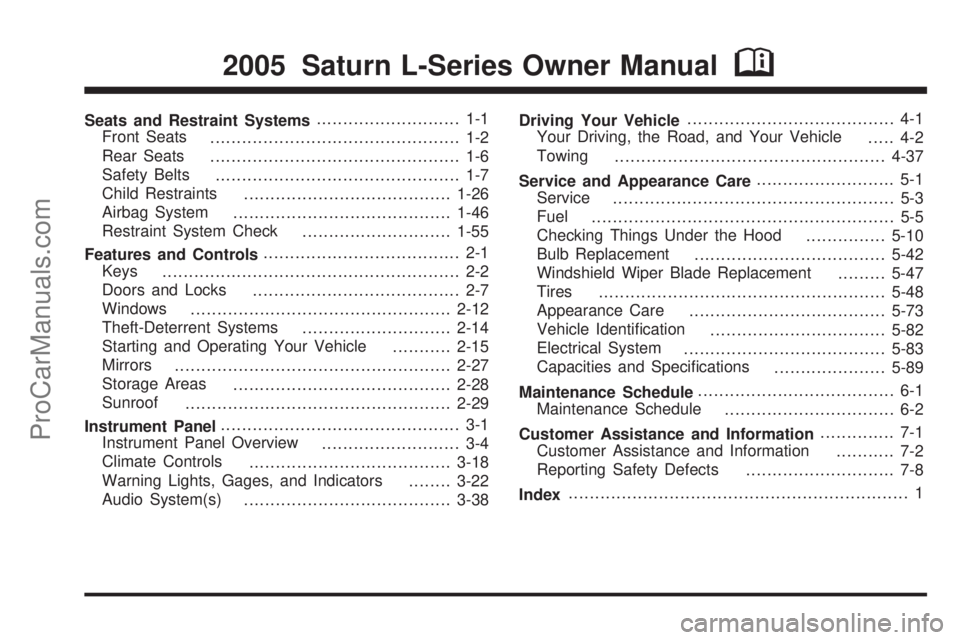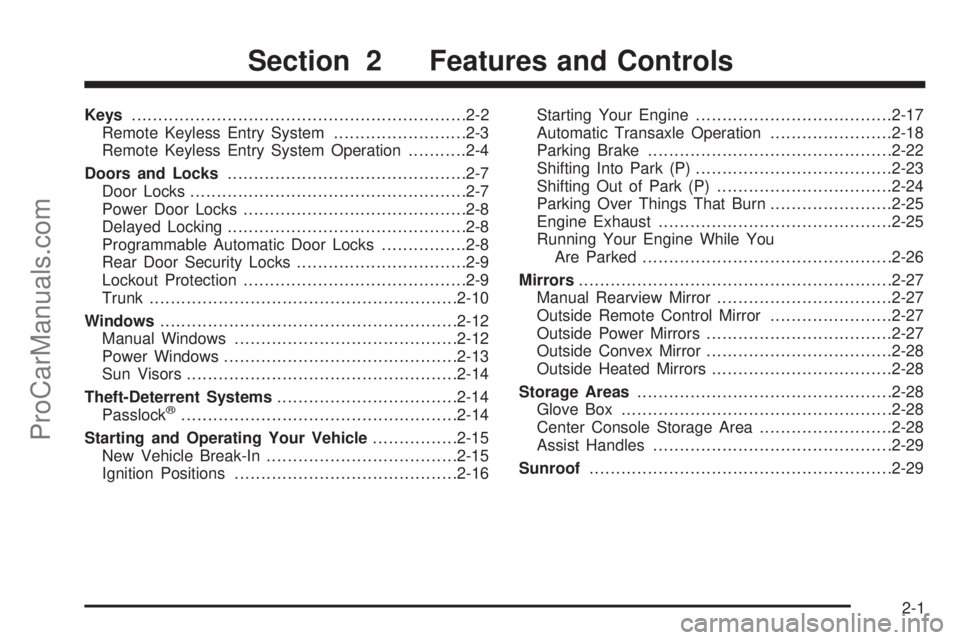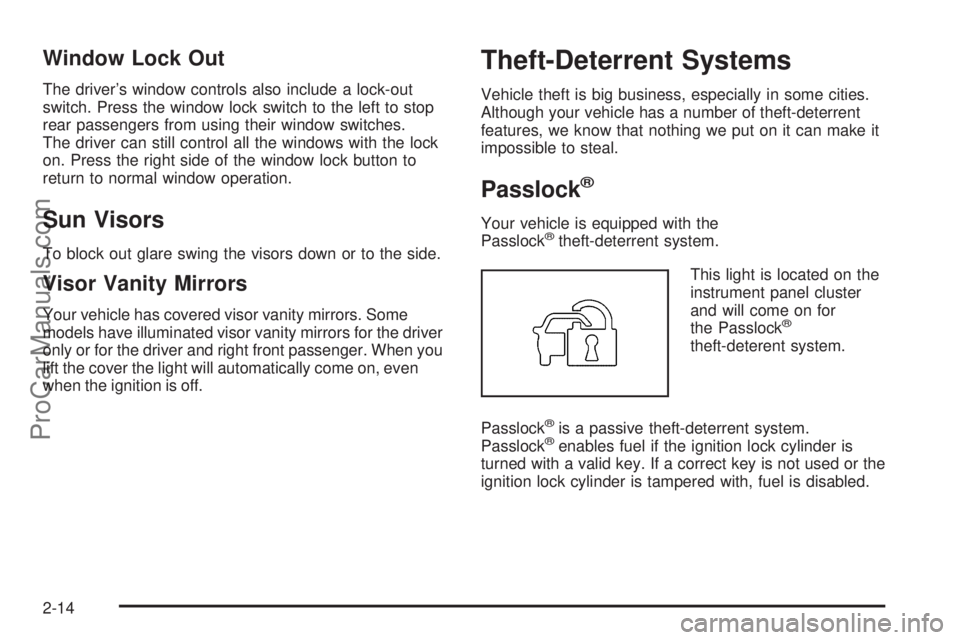mirror SATURN L-SERIES 2005 Owners Manual
[x] Cancel search | Manufacturer: SATURN, Model Year: 2005, Model line: L-SERIES, Model: SATURN L-SERIES 2005Pages: 330, PDF Size: 2.4 MB
Page 1 of 330

Seats and Restraint Systems........................... 1-1
Front Seats
............................................... 1-2
Rear Seats
............................................... 1-6
Safety Belts
.............................................. 1-7
Child Restraints
.......................................1-26
Airbag System
.........................................1-46
Restraint System Check
............................1-55
Features and Controls..................................... 2-1
Keys
........................................................ 2-2
Doors and Locks
....................................... 2-7
Windows
.................................................2-12
Theft-Deterrent Systems
............................2-14
Starting and Operating Your Vehicle
...........2-15
Mirrors
....................................................2-27
Storage Areas
.........................................2-28
Sunroof
..................................................2-29
Instrument Panel............................................. 3-1
Instrument Panel Overview
.......................... 3-4
Climate Controls
......................................3-18
Warning Lights, Gages, and Indicators
........3-22
Audio System(s)
.......................................3-38Driving Your Vehicle....................................... 4-1
Your Driving, the Road, and Your Vehicle
..... 4-2
Towing
...................................................4-37
Service and Appearance Care.......................... 5-1
Service
..................................................... 5-3
Fuel
......................................................... 5-5
Checking Things Under the Hood
...............5-10
Bulb Replacement
....................................5-42
Windshield Wiper Blade Replacement
.........5-47
Tires
......................................................5-48
Appearance Care
.....................................5-73
Vehicle Identification
.................................5-82
Electrical System
......................................5-83
Capacities and Specifications
.....................5-89
Maintenance Schedule..................................... 6-1
Maintenance Schedule
................................ 6-2
Customer Assistance and Information.............. 7-1
Customer Assistance and Information
........... 7-2
Reporting Safety Defects
............................ 7-8
Index................................................................ 1
2005 Saturn L-Series Owner ManualM
ProCarManuals.com
Page 63 of 330

Keys...............................................................2-2
Remote Keyless Entry System.........................2-3
Remote Keyless Entry System Operation...........2-4
Doors and Locks.............................................2-7
Door Locks....................................................2-7
Power Door Locks..........................................2-8
Delayed Locking.............................................2-8
Programmable Automatic Door Locks................2-8
Rear Door Security Locks................................2-9
Lockout Protection..........................................2-9
Trunk..........................................................2-10
Windows........................................................2-12
Manual Windows..........................................2-12
Power Windows............................................2-13
Sun Visors...................................................2-14
Theft-Deterrent Systems..................................2-14
Passlock
®....................................................2-14
Starting and Operating Your Vehicle................2-15
New Vehicle Break-In....................................2-15
Ignition Positions..........................................2-16Starting Your Engine.....................................2-17
Automatic Transaxle Operation.......................2-18
Parking Brake..............................................2-22
Shifting Into Park (P).....................................2-23
Shifting Out of Park (P).................................2-24
Parking Over Things That Burn.......................2-25
Engine Exhaust............................................2-25
Running Your Engine While You
Are Parked...............................................2-26
Mirrors...........................................................2-27
Manual Rearview Mirror.................................2-27
Outside Remote Control Mirror.......................2-27
Outside Power Mirrors...................................2-27
Outside Convex Mirror...................................2-28
Outside Heated Mirrors..................................2-28
Storage Areas................................................2-28
Glove Box...................................................2-28
Center Console Storage Area.........................2-28
Assist Handles.............................................2-29
Sunroof.........................................................2-29
Section 2 Features and Controls
2-1
ProCarManuals.com
Page 76 of 330

Window Lock Out
The driver’s window controls also include a lock-out
switch. Press the window lock switch to the left to stop
rear passengers from using their window switches.
The driver can still control all the windows with the lock
on. Press the right side of the window lock button to
return to normal window operation.
Sun Visors
To block out glare swing the visors down or to the side.
Visor Vanity Mirrors
Your vehicle has covered visor vanity mirrors. Some
models have illuminated visor vanity mirrors for the driver
only or for the driver and right front passenger. When you
lift the cover the light will automatically come on, even
when the ignition is off.
Theft-Deterrent Systems
Vehicle theft is big business, especially in some cities.
Although your vehicle has a number of theft-deterrent
features, we know that nothing we put on it can make it
impossible to steal.
Passlock®
Your vehicle is equipped with the
Passlock®theft-deterrent system.
This light is located on the
instrument panel cluster
and will come on for
the Passlock
®
theft-deterent system.
Passlock
®is a passive theft-deterrent system.
Passlock®enables fuel if the ignition lock cylinder is
turned with a valid key. If a correct key is not used or the
ignition lock cylinder is tampered with, fuel is disabled.
2-14
ProCarManuals.com
Page 89 of 330

Mirrors
Manual Rearview Mirror
If the vehicle has this mirror, while sitting in a
comfortable driving position, adjust the mirror so you
can see clearly behind the vehicle. Grip the mirror in the
center to move it up or down and side to side. The
day/night adjustment, located at the bottom of the mirror,
allows adjustment to lessen glare from the lamps
behind you. Pull the lever for daytime use; push it for
night use.
Outside Remote Control Mirror
If the vehicle has this feature, adjust the driver’s side
outside mirror to the desired direction by moving
the control, located on the driver’s door. To adjust the
passenger’s side outside mirror, move the control
located on the passenger’s door. Adjust each mirror so
that the driver can see the side of the vehicle and
the area beside and behind it.
Outside Power Mirrors
If the vehicle has this
feature, the outside power
mirror control is located
on the driver’s door.
Use the selector switch located above the round touch
pad to choose either the driver’s or passenger’s
outside mirror. To adjust the mirror press the round
touch pad in the desired direction.
Adjust each mirror so that the side of the vehicle and
the area beside and behind it are visible while sitting in a
comfortable driving position.
2-27
ProCarManuals.com
Page 90 of 330

Outside Convex Mirror
{CAUTION:
A convex mirror can make things (like other
vehicles) look farther away than they really are.
If you cut too sharply into the right lane, you
could hit a vehicle on your right. Check your
inside mirror or glance over your shoulder
before changing lanes.
The passenger’s side mirror is convex. A convex
mirror’s surface is curved so more can be seen from
the driver’s seat. It also makes things appear farther
away than they really are.
Outside Heated Mirrors
When the rear window defogger is turned on, it also
warms both outside rearview mirrors to help clear them
of ice, snow, or condensation. SeeClimate Control
System on page 3-18.
Storage Areas
Glove Box
To open the glove box, lift up on the lever. The glove
box has a light inside.
Center Console Storage Area
Your vehicle is equipped with a center console.
To open the console’s storage area, pull up on the
latch located in the front of the console lid.
2-28
ProCarManuals.com
Page 91 of 330

Assist Handles
A handle above the front passenger’s door and both
rear doors can be used when getting in and out of your
vehicle. The assist handle provides assistance, but
should not be used to support all or even a substantial
portion of a person’s weight.
Sunroof
If your vehicle has this
feature, the switch will be
located above your
rearview mirror. Your
ignition key must be in the
RUN or ACC position to
operate the sunroof.To open the sunroof three-quarters of the way, press
and hold the SLIDE portion of the switch. To open
the sunroof all the way, press and hold the SLIDE
portion of the switch again. To close the sunroof, press
and hold the TILT portion of the switch.
To place the sunroof in the vent position when the
sunroof is closed, press and hold the TILT portion of the
switch. The rear of the sunroof will be raised to
provide ventilation. To close the sunroof from the vent
position, press and hold the SLIDE portion of the switch.
2-29
ProCarManuals.com
Page 108 of 330

Dome Lamp
The dome lamp switch has three positions.
ON:The lamp will stay on as long as the switch is in
this position.
DOOR:The lamp will come on when a door is opened.
See “Entry Lighting” for more information.
OFF:The lamp will not come on as long as the switch
is in this position.
Entry Lighting
If the dome lamp is in the DOOR position, the lamps
inside your vehicle will come on when any door is
opened. In addition, the light will come on when the
remote keyless entry unlock button is pressed. It
will stay on for 20 seconds or until a door is opened.
After the door is opened the light will remain on and
stay on for 20 seconds after the doors are closed,
or until you put the key in the ignition and turn the key
to RUN. The light will then gradually dim until it is
no longer lit.
Map Lamps
Your vehicle may have map lamps on the rearview
mirror. Press the button next to the lamp to turn it on
and off.
Battery Run-Down Protection
Your vehicle is equipped with a battery saver feature
designed to protect your vehicle’s battery.
When any interior lamp is left on and the ignition is
turned off, the battery rundown protection system will
automatically turn the lamp off after 20 minutes.
Accessory Power Outlets
The accessory power outlets can be used to connect
electrical equipment such as a cellular phone or
CB radio.
The accessory power outlets are located in the front
and rear of the center console.
To use the outlet, remove the cover. When not in use,
always cover the outlet with the protective cap.
3-16
ProCarManuals.com
Page 112 of 330

1(Defrost):This mode directs most of the air to the
windshield with some air directed to the floor vents.
In this mode, the system will automatically force outside
air into your vehicle and run the air-conditioning
compressor. Recirculation cannot be selected while in
the defrost mode.
Rear Window Defogger
The rear window defogger uses a warming grid to
remove fog or frost from the rear window.
button will come on to let your know that the rear
window defogger is activated. Be sure to clear as much
snow from the rear window as possible.
The rear window defogger will turn off approximately
15 minutes after the button is pressed. If turned on
again, the defogger will only run for approximately seven
minutes before turning off. The defogger can also be
turned off by pressing the button again or by turning off
the engine.
If your vehicle has heated outside mirrors, the mirrors
will also heat when the rear defogger is on. SeeOutside
Heated Mirrors on page 2-28for more information.Notice:Don’t use anything sharp on the inside of
the rear window. If you do, you could cut or damage
the warming grid, and the repairs wouldn’t be
covered by your warranty. Do not attach a temporary
vehicle license, tape, a decal or anything similar
to the defogger grid.
Outlet Adjustment
Use the louvers located on the air outlets to change the
direction of the airflow.
Operation Tips
•
Clear away any ice, snow, or leaves from the air
inlets at the base of the vehicle that may block
the flow of air into your vehicle.
•Use of non-GM approved hood deflectors may
adversely affect the performance of the system.
•Keep the path under the front seats clear of objects
to help circulate the air inside of your vehicle more
effectively.
3-20
ProCarManuals.com
Page 168 of 330

•Do not get too close to the vehicle you want to
pass while you are awaiting an opportunity. For one
thing, following too closely reduces your area of
vision, especially if you are following a larger
vehicle. Also, you will not have adequate space if
the vehicle ahead suddenly slows or stops.
Keep back a reasonable distance.
•When it looks like a chance to pass is coming up,
start to accelerate but stay in the right lane and do
not get too close. Time your move so you will be
increasing speed as the time comes to move into the
other lane. If the way is clear to pass, you will have a
running start that more than makes up for the
distance you would lose by dropping back. And if
something happens to cause you to cancel your
pass, you need only slow down and drop back again
and wait for another opportunity.
•If other vehicles are lined up to pass a slow vehicle,
wait your turn. But take care that someone is not
trying to pass you as you pull out to pass the slow
vehicle. Remember to glance over your shoulder and
check the blind spot.
•Check your mirrors, glance over your shoulder, and
start your left lane change signal before moving out
of the right lane to pass. When you are far enough
ahead of the passed vehicle to see its front in your
inside mirror, activate your right lane change signal
and move back into the right lane. Remember that
your right outside mirror is convex. The vehicle you
just passed may seem to be farther away from you
than it really is.
•Try not to pass more than one vehicle at a time
on two-lane roads. Reconsider before passing the
next vehicle.
•Do not overtake a slowly moving vehicle too rapidly.
Even though the brake lamps are not flashing, it may
be slowing down or starting to turn.
•If you are being passed, make it easy for the
following driver to get ahead of you. Perhaps you can
ease a little to the right.
4-14
ProCarManuals.com
Page 169 of 330

Loss of Control
Let us review what driving experts say about what
happens when the three control systems — brakes,
steering, and acceleration — do not have enough friction
where the tires meet the road to do what the driver
has asked.
In any emergency, do not give up. Keep trying
to steer and constantly seek an escape route or
area of less danger.
Skidding
In a skid, a driver can lose control of the vehicle.
Defensive drivers avoid most skids by taking reasonable
care suited to existing conditions, and by not overdriving
those conditions. But skids are always possible.
The three types of skids correspond to your vehicle’s
three control systems. In the braking skid, your wheels
are not rolling. In the steering or cornering skid, too much
speed or steering in a curve causes tires to slip and lose
cornering force. And in the acceleration skid, too much
throttle causes the driving wheels to spin.
A cornering skid and an acceleration skid are best
handled by easing your foot off the accelerator pedal.If your vehicle starts to slide, ease your foot off the
accelerator pedal and quickly steer the way you want
the vehicle to go. If you start steering quickly enough,
your vehicle may straighten out. Always be ready
for a second skid if it occurs.
Of course, traction is reduced when water, snow, ice,
gravel, or other material is on the road. For safety, you
will want to slow down and adjust your driving to
these conditions. It is important to slow down on slippery
surfaces because stopping distance will be longer and
vehicle control more limited.
While driving on a surface with reduced traction, try
your best to avoid sudden steering, acceleration,
or braking, including engine braking by shifting to a
lower gear. Any sudden changes could cause the tires
to slide. You may not realize the surface is slippery
until your vehicle is skidding. Learn to recognize warning
clues — such as enough water, ice, or packed snow
on the road to make a mirrored surface — and
slow down when you have any doubt.
If you have the anti-lock braking system, remember: It
helps avoid only the braking skid. If you do not have
anti-lock, then in a braking skid, where the wheels are
no longer rolling, release enough pressure on the brakes
to get the wheels rolling again. This restores steering
control. Push the brake pedal down steadily when
you have to stop suddenly. As long as the wheels are
rolling, you will have steering control.
4-15
ProCarManuals.com